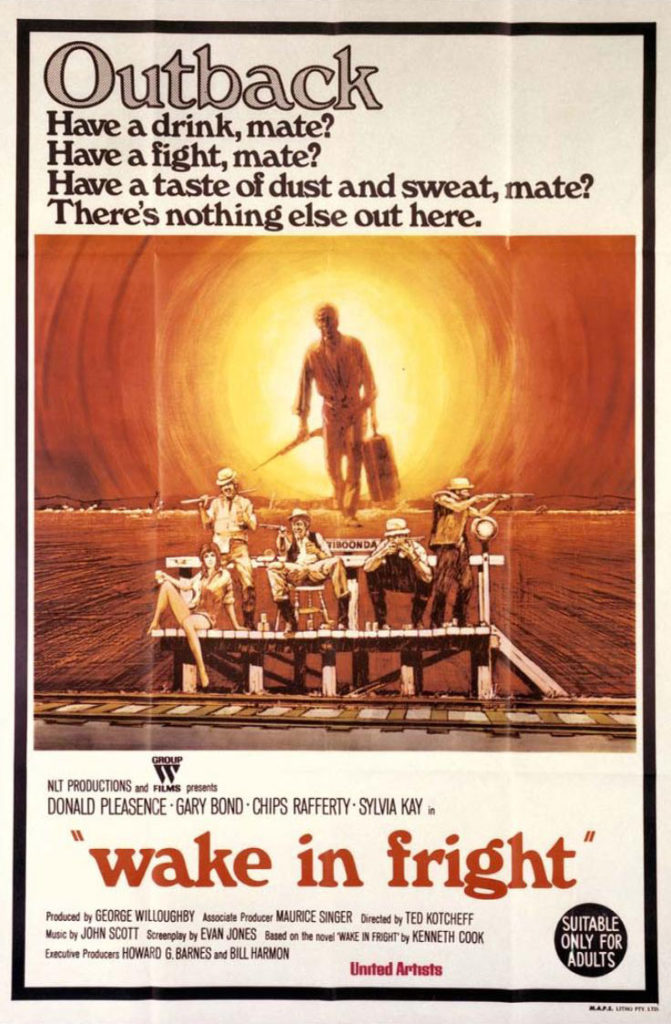I can get the heart of this review out of the way quickly. Wake in Fright is the best movie I have seen in at least the last couple of years. Directed by Ted Kotcheff and written by Evan Jones, Wake in Fright has an interesting history. From 1971, it was close to being a lost film for a long time, with the only known copy in existence of such poor quality that it was unfit for transfer to home media. Twenty years ago, Anthony Buckley, who edited the original film, began to search for an intact copy. After much effort, he succeeded. A restoration was finally undertaken in 2009, and the film was released to the general public once again.
The film follows John Grant (Gary Bond), an indentured teacher serving out a contract in Tiboonda, middle of nowhere, Australian Outback. To call it a one-horse town would be to vastly overstate its size. Grant is unhappy with his job, and relishes the six-week holiday he is to spend with his girlfriend in Sydney. But first, he has to get there. The loneliest train in the world is his ticket out of Tiboonda, but on the way home, he stops for a night in the mining town of Bundanyabba, and everything goes completely wrong for Mr. Grant.
The Yabba, as the locals call it, is a shocking place for Grant’s sensibilities. He considers himself an educated man, with urbane sophistication. He looks at the people of the Yabba and sees the unwashed masses, worthy of nothing but his contempt. The first person he meets in town is the local sheriff (Chips Rafferty), who gamely takes Grants backhanded jibes and insults in stride, revealing that while Grant may have an education, there is quite a bit he needs to learn about manners.
Grant gets himself into a bit of drunken trouble in town, losing all his money gambling, and finds that he is stuck in the Yabba. It is here that Grant begins to really lose it, spending the following days on a downward spiral of drunkenness that is hellish to  behold. At first blush, Grant may have been harsh to judge the locals in the way he did, but it turns out there was some basis in fact. But, as rough and tumble as the locals are, the real monster of this film is Grant. He matches everyone he meets, debauchery to debauchery, finally creating in himself a crisis of conscience that threatens to not just ruin his life, but end it.
behold. At first blush, Grant may have been harsh to judge the locals in the way he did, but it turns out there was some basis in fact. But, as rough and tumble as the locals are, the real monster of this film is Grant. He matches everyone he meets, debauchery to debauchery, finally creating in himself a crisis of conscience that threatens to not just ruin his life, but end it.
Grant is joined in his shenanigans by Donald Pleasence as Doc Tydon, a refugee from the city, who finds that his extreme alcoholism is hardly remarked upon in the Yabba. Many years ago, when I thought of Donald Pleasence, I thought of the shouty, unhinged man who was in all those awful Halloween sequels. That was giving him short shrift. Donald Pleasence was a fine actor — one of the best, in fact. There are some films he was in, such as Alone in the Dark, where a viewer could tell he clearly relished his role, and his exuberance becomes infectious. Wake in Fright is another of those roles. Doc Tydon is an intelligent figure, but a man who wallows in squalor. His misfortunes stem from poor personal decisions, but he is never unaware of where his appetites have led him. Doc Tydon is nothing less than a warning for John Grant, and one he chooses to ignore.
Wake in Fright could be a hard watch for some people. The characters that populate the film have little in the way of redeeming qualities, and that includes the lead. There’s also very little hope. Going in, one may expect that Grant is someone the audience could root for, someone we would like to see overcome his failings. Were Grant a likable person, maybe he would earn such empathy from a viewer. But he’s not. Wake in Fright is a graphic exploration of what can happen when personal demons are allowed free reign. It also made me afraid of Australia, for some reason. Either way, this film is an artistic accomplishment of the highest order, and I could not be more glad that Anthony Buckley’s efforts to save this film bore fruit.
